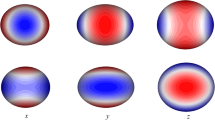Abstract
The Earth is taken as a triaxial rigid body, which rotates freely in the Euclidian space. The starting equations are the Euler dynamic equations, with A smaller than B and B smaller than C. The Euler equations are solved, and the numerical results are provided. In the calculations, the following parameters are used: (C-B)/A=0.003 273 53; (B-A)/C=0.000 021 96; (C-A)/B=0.003 295 49, and the mean angular velocity of the Earth’s rotation, ω=0.000 072 921 15 rad/s. Calculations show that, besides the self-rotation of the Earth and the free Euler procession of its rotation, there exists the free nutation: the nutation angle, or the angle between the Earth’s momentary rotation axis and the mean axis that periodically change with time. The free nutation is investigated.
Similar content being viewed by others
References
Groten E (2000) Parameters of common relevance of astronomy, geodesy, and geodynamics[J]. Journal of Geodesy, 74: 134–140
Goldstein H, Poole C, Safko J (2002) Classical mechanics (3rd ed.)[M]. Massachusetts: Addison-Wesley Press
Qiang Yuanqi (2003) Classical mechanics II[M]. Beijing: Science Press (in Chinese)
Lambeck K (1980) The Earth’s variable rotation: geophysical causes and consequences[M]. Cambridge: Cambridge University Press
Weinberg S (1972) Gravitation and cosmology[M]. New York: John Wiley and Sons
Burśa M, Śima Z (1984) Equatorial flattening and principal moments of inertia of the Earth[J]. Studia Geoph et Geod, 28: 9–10
Liu H S, Chao B F (1991) The Earth’s equatorial principal axes and moments of inertia[J]. Journal of Geophysical Research, 106: 699–702
Yoder C F (1995) Astrometric and geodetic properties of Earth and the solar system[M]//Ahrens T J. Global Earth physics: a handbook of physical constants. Washington D C: American Geophysical Union
NIMA (2000) World geodetic system 1984 [R]. NIMA TR 8350, National Imagery and Mapping Agency, Bethesda, Maryland
Wei Ziqing (2005) Earth’s principal moments of inertia[J]. Acta Geodaetica et Cartographica Sinica, 34(1): 7–13 (in Chinese)
Wang Wenjun (2004) Dynamical mechanism for secular trend [C]//Zhu Yaozhong, Sun Heping. Proceedings on Geodesy and Geodynamics. Wuhan.: Hubei Science and Technology Press: 706–715
Wang Wenjun, Shen Wenbin (2006) Chaotic reversals of geomagnetic poles[C]. COSPAR 36th Joint Assembly, Beijing
Author information
Authors and Affiliations
Additional information
Funded by the National Natural Science Foundation of China (No.40574004).
About this article
Cite this article
Shen, W., Chen, W., Wang, W. et al. Rotation of the Earth as a triaxial rigid body. Geo-spat. Inf. Sc. 10, 85–90 (2007). https://doi.org/10.1007/s11806-007-0020-5
Received:
Issue Date:
DOI: https://doi.org/10.1007/s11806-007-0020-5




